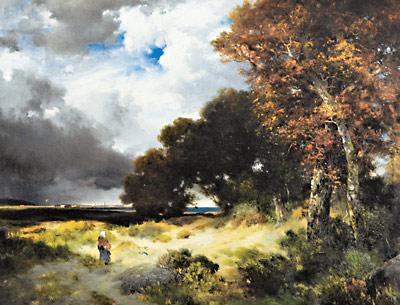Surprises Abound In Moran Family Exhibition

Upon hearing that a Moran family show is opening in East Hampton, it is difficult not to prepare for disappointment. Despite the rich history the family has in this village and town, it seems that it is always the usual few things that are trotted out — a palette from the library here, some etchings there, a couple of paintings from Guild Hall. There is a decent representation to be had from the typical local vaults, but all items are a little too familiar at this point to be worth taking much notice of.
What a delight, then, to come upon the engaging exhibition that the East Hampton Historical Society has put together with Charles Keller and Glenn Purcell, two volunteer curators and Dominy enthusiasts who turned their attention to Moran as part of their fascination with East Hampton history.
Their enthusiasm must be contagious, because the loans in this show from several private East Hampton collections are really outstanding examples of the entire family’s oeuvre. Thomas Moran, the man whose depictions of this country’s natural treasures such as Yellowstone, almost single-handedly brought about the creation of the National Parks program, is well represented here with surprisingly superior paintings as well as documents of his working approach, photographs, and, of course, the requisite etchings.
Yes, the library’s palette is here, but brought out into the light, floating in its vitrine in a way that suggests that it is waiting for its owner to return momentarily. Everything has a lively air to it. The spotlights on the paintings bring out all of their subtlety while not interfering with the more delicate paper works. Even the chest from the studio, walked over from the East Hampton Library, gets a fresh and light-filled airing with all of its intricate carving, believed by the organizers now to be from India instead of Italy as was once assumed. Outside of its darker and more familiar habitat, it can be appreciated anew.
Even the old photographs of the places taken around the time Moran was painting them look less archival and more interactive in this dynamic setting. Moran’s two paintings are the real standouts, however. One, “Hook Pond in Shadow, Looking Toward the Atlantic” from 1904, shows Moran taking on the local landscape the way he might approach the Grand Tetons, with an open and Western feeling, far more exuberant than the tamer Hudson River School style he adopted earlier for these subjects. Easel-size, its dramatic sky and open vista seems grander.
His more intimate oil-on-tile painting of an “East Hampton Landscape” from 1880 has the more familiar feel, but its detail and delicacy amid the summary brushwork are extraordinary. One could look at the reflections of the vegetation in the water for hours and still find something new in them.
While Thomas was arguably the most famous and significant of the Morans, it is a family show and there are a number of small galleries devoted to the rest of the clan. There are his wife Mary Nimmo Moran, his brothers Peter and Edward, and his nephews Leon Moran and Edward Percy Moran, among others.
Some of the family members worked almost entirely in etching, including Mary and Peter, who was known for his Barbizon-style depictions of rural subjects, painted primarily in Pennsylvania and the Southwest, although he was a visitor here.
Mary Nimmo Moran, revered for her intricate etchings rendered as fully formed original works in their own right, is also well represented, with some of her popular East Hampton views on display as well as one of her original etching plates and a photograph of her in her garden.
Historically, etching was often considered a reductive studio pursuit, inferior to painting, but used to replicate certain paintings to make them available to a larger audience, both for higher purposes such as devotional images, or baser ones, including erotica. Etchers often worked separately from the artist who produced the original work, copying it faithfully if not exactly.
While she also painted, Mary was one of those artists who viewed etching as an end in itself and she could be found in East Hampton, sometimes with her husband, out in nature and working on the plate directly from what she saw rather than through an elaborate preliminary sketching process. Although she signed her works M. Nimmo Moran to keep her gender private, she was a member of both the Society of Painter-Etchers of New York and the only woman of the original members of the Fellows of London’s Royal Society of Painter-Etchers.
Edward Moran’s dramatic painted seascapes were what defined him. There are a couple of examples in the show that give some hint of why he was compared to J.M.W. Turner and considered one of the best marine painters of his era.
The second generation of artists is also represented in the show, both of whom focused on more figurative works, all apparently striving for their own identities. Percy painted historical and colonial subjects, often dressing his relatives up in old costumes to paint them for his compositions.
As the inclusion of the chest attests, the show attempts to make the lives of the family members tangible. There is a chair from Moran’s studio with a photograph of the studio from the time they were there as a mural backdrop. A photograph of Moran working in the studio is included. Other souvenirs that capture the Morans’ lives and times are placed throughout to keep the personal lives present in each of the individual displays.
During the installation, Mr. Keller and Mr. Purcell emphasized this living history aspect to the show. Surveying the sum of their work in the gallery, they were pleased and grateful to have so many outstanding loans, overwhelmed by the generosity of the lenders. Because so many works in the show are in private hands, it is imperative to visit soon. The exhibition comes down July 8.
